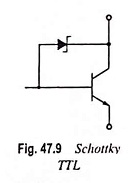TTL Characteristics and other TTL Series:
The first time standard TTL ICs were introduced by Taxas Instruments Corporation. They introduced 54 and 74 series, which were widely used as IC logic families. The major difference in these two series is that 54 series can operate over a wider range of temperatures and power-supply voltages. Many other manufacturers have also started producing such IC series and they all use the same numbering system except the prefix. TTL characteristics of its series is given by :
- High Voltage Range : Normal supply voltage (VCC for both the 54 and 74 series) is 5 V. 54 series operates reliably over the range of 4.5 to 5.5 V but 74 series operates reliably over the range of 4.75 to 5.25 V.
- Temperature Range : 54 series operates properly in ambient temperature ranging from – 55°C to +125°C while 74 series operates only in the range from 0°C to 70°C.
- Power Dissipation : A standard TTL NAND gate takes an average power of 10 milliwatts.
- Propagation Delay Time : It is approximately 9 nanosecond (ns) for a TTL NAND gate.
- Device Numbers : Different TTL devices can be designed by varying the number of multiple emitter inputs and totem pole output. In the table given, a list is given in which IC numbers are shown and its description is given against each of them.
IC Number |
Description |
| 7400 | Quad 2-input NAND gates |
| 7402 | Quad 2-input NOR gates |
| 7404 | Hex inverter |
| 7408 | Quad 2-input AND gates |
| 7410 | Triple 3-input NAND gates |
| 7411 | Triple 3-input AND gates |
| 7420 | Dual 4-input NAND gates |
| 7421 | Dual 4-input AND gates |
| 7442 | BCD to decimal decoder |
| 7470 | Edge triggered J-K flip-flop |
| 7472 | J-K master-slave flip-flop |
| 7474 | Dual D flip-flop |
| 7483 | 4-bit binary full-adder |
| 7490 | Decade counter |
Because of greater tolerance of voltage and temperature variations, the 54 series is more expensive. It is employed only in applications where reliable operation is required to be maintained over an extreme range of conditions such as military and space applications.
Other TTL Series:
After development and successful operation of standard TTL 74 series ICs, several other TTL series ICs have been developed which provide a wide choice of speed and power characteristics. These series are explained below:
1. Low Power TTL (74L Series). It has the same basic circuit as the 74 standard series. The only difference is that the values of all the internal resistances are increased in order to reduce power requirement of TTL gates. On the other hand due to increase in values of the internal resistances propagation delay time of the device increases. Nowadays this series has become obsolete because of development of other low power and high speed operation series.
2. High Speed TTL (74H Series). Propagation delay time of this series is low as compared to standard 74 series. In this series, values of internal resistances of standard 74 series circuit are lowered, which reduces internal time constant and so the device becomes faster in operation. On the other hand the power consumption, owing to decrease in the values of resistances. This series has also become obsolete because of development of other series.
3. Schottky TTL (74S Series). This is called 74S series. In the 74 series, 74L series and 74H series, transistors go into deep saturation which causes some extra carriers to be stored in the base of transistors. When transistor is switched on and it goes from saturation to cut-off, these extra carriers cause delay as they have to flow out of the base. This delay is called saturation delay time.
In order to eliminate the effect of the deep saturation of transistors on propagation delay time, Schottky barrier diode (SBD) is connected between the base and collector of each transistor, as shown in Fig. 47.9.
The SBD has forward voltage of 0.25 V so it prevents the transistor from saturating fully. This way saturation delay time gets eliminated and switching of transistor becomes faster.
To further reduce the propagation delay time low value resistances are used in the circuit, so power dissipation in this series is high.
4. Low Power Schottky TTL (74LS Series). In this series a compromise between the low power requirement and high speed is made by using high value internal resistances.
5. Advanced Schottky TTL (74AS Series). Recent developments in the field of IC design has made it possible to further reduce the propagation delay time of TTL devices. This series is much faster than TTL 74S series with low power requirement. So TTL 74AS series is replacing the 74S series in all high speed applications.
6. Advanced Low Power Schottky TTL (74ALS Series). This series offers further reduction in power dissipation and propagation delay time over the 74LS series.
Comparison of TTL Series:
Following table gives the comparison of propagation delay time and power dissipation in all the TTL series.

